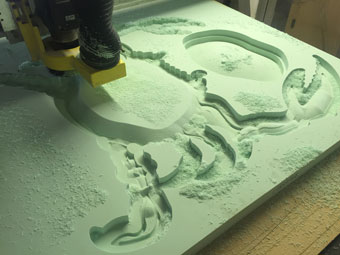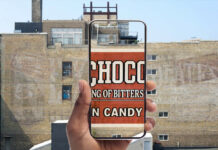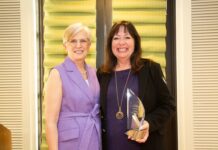The Crab House is a seafood grill located in historic Fisherman’s Wharf in Monterey, California, yet they were having trouble pulling patrons into their establishment. Owner Michael Zaouck thought their plain sign was getting lost amidst the barrage of competing restaurants in the district.
Zaouck knew he was going to need a truly eye-catching, blockbuster sign for his building.
The end-result is a 112-by-40-inch identity sign featuring a designed-from-scratch large-sized crab and dimensional letters router-cut from high-density urethane, outlined with LED lighting, and attached to a customized steel frame bracket. Carefully positioned spotlights add to its enticing effect.
The company responsible for designing, fabricating, and installing this stunning sign is Signs by Van, a six-person shop based in nearby Salinas, California that specializes in custom, high-end dimensional signage and murals. For over the past thirty-five years, they’ve crafted a number of creative 3D projects out of redwood, cedar, and HDU.
Owner Phil VanderKraats honed his skills in the metal works, welding, and wax casting industries before he made his first sandblasted sign back in 1981. He’s also studied dimensional art for years. “I’m constantly looking at what’s out there, in order to provide the best product for our customers,” he says.
Signs by Van credits their design skills, craftsmanship, and (most importantly) passion for their sign success. Phil preaches the timeless quote: “Good enough seldom is.”
One could correctly label the shop as perfectionists. “More times than not, we have to remind our team that, yes, the sign looks awesome but to stop tinkering with it because it’s costing us money,” says Phil. “Then again, quality is how we built our reputation—so what is too much?
“Our signs are built to last for twenty-five years, particularly since our clients are, most of the time, willing to pay for that quality.”
Phil credits Zaouck as being an exceptional client who gave his shop “cart blanche” on design and sign placement in order to deliver a sign that screams, ‘Walk on in!’”

Interestingly the new sign for the Crab House is the first time Signs by Van incorporated LED border lighting into the final design. The city of Monterey recently gave businesses the go-ahead to be more creative with their lighting solutions, so the shop saw this as an opportunity to try out something new themselves.
Since this was their first LED project, the shop learned several things here—(1.) install a dimmer in case the lights are too bright, (2.) add exterior spotlighting so the sign won’t be overpowered by the LEDs, and (3.) include electrical work into the budget.
“When we mixed heavy dimension with Sign Lighting World’s RGB Flex Neon LED, we got awesome!” says Phil’s son Jeremy, a principal at Signs by Van. “The sign has received rave reviews from tourists, the city, and even their competitors on the Wharf who, of course, now need a new sign upgrade!”
Signs by Van boasts a variety of tools to aid them in their dimensional sign-making quest—such as, traditional hand-carving tools, paint brushes, sandblasting systems, and a MultiCam 1000 Series CNC router.
In fact, they’re using the MultiCam router on an increasing number of applications each year—whether cutting complex sign shapes out of wood or foam, routing out letters, adding textures into backgrounds, or creating intricate character add-ons. They base their decision of whether to bring out the CNC router on cost effectiveness.
For example, if a project is going to take more time to design and produce via the CNC router, they’ll let their hand-carvers tackle the job instead. “On some jobs, our carving team still has to touch up the finished routed pieces based on the level of detail our machinists puts into the route job,” says Jeremy.
The crab and letters for the new Crab House sign were router-cut using 3/8-inch bits from fifteen-pound CORAFOAM® HDU from DUNA-USA. Signs by Van have been using this substrate exclusively for over the past seven years. “It’s easy to touch up and finish after it’s been routed,” says Jeremy.
One reason they prefer fifteen-pound HDU is its workability and ease of post-fabrication preparation. To add durability (depending on the application), Jeremy says, “We’ll hard-coat the foam after we route, carve, or sandblast it.”
When it comes to painting, Signs by Van uses Behr Ultra Premium Exterior on all their outdoor signs. “Two coats will do the trick,” says Jeremy. “It dries quickly and lasts a long time.”

The shop also uses Painters One-Shot as the coating for any sign that requires a glossy finish.
They also like Nova Color acrylic paints, which they use for all indoor/outdoor murals, as well as large detail work on signs. “They have a line of acrylics that have long-lasting, brilliant colors,” says Jeremy, adding that, when necessary, they’ll also apply a coat of Nova’s Exterior Matte Varnish for extra durability and longevity.
On the Crab House sign, the shop wasn’t going for realism—instead they wanted more bright and colorful hues. “So we faded latex Nova Color paints onto the sign components,” says Jeremy.
When it comes to weather proofing and durability, Signs by Van will spray Bondo Fiberglass Resin over the entire sign face, wait ten minutes, and then spray Evercoat® Slick Sand™ Polyester Primer Surfacer 100-709 right over the resin. “This will result in an ultra-smooth finish that’s easily sandable,” says Jeremy.
As mentioned earlier, Signs by Van is located in Salinas, which is also home to a “bustling” architectural industry and located near some of the largest wine-grape producing regions of the state. This has opened the doors for the sign shop to design and build dimensional creations for nearby wineries and farms, as well as various stops along U.S. Highway 101.
One thing that Signs By Van has learned about businesses in the area is that several of them have been using the same branding for years and don’t really want to change their design. So they’ve had to figure out ways to work with this.
Take the work they recently did for Century Oak wineries, where Signs By Van decided to incorporate their long-time logo in a new way onto an already-functioning sign. “We actually vectored a photo of a one hundred-year-old oak tree from the property and based the design off of that,” explains Jeremy. “The owner wanted the sign to evolve over time—therefore the letters and border are stainless and the background is plate steel that will rust forever and change through the seasons.”
Meanwhile Signs by Van’s business model is growing, as they’re now accepting orders to provide nationwide wholesale signage. They’re also looking into investing in a MultiCam Series 5000 CNC router, as well as adding a plasma cutter sooner rather than later to increase their job turnaround times.
Signs by Van recognize that, in this current economy, potential clients are budget-driven and some aren’t necessarily looking for show-stopping signage. Still they’re proud of being able to find ways of adding value to a client’s signage all the while saving them from going over-budget—while still creating captivating signs that garner attention.
By Jeff Wooten
All photos: Signs by Van











